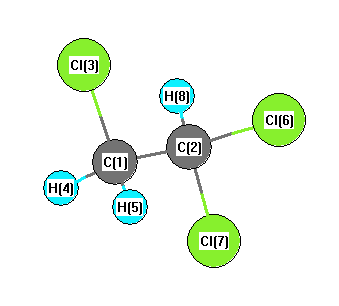Vibrational Frequencies calculated at HF/6-311G*
| Mode Number |
Symmetry |
Frequency
(cm-1) |
Scaled Frequency
(cm-1) |
IR Intensities
(km mol-1) |
Raman Act
(Å4/u) |
Dep P |
Dep U |
|---|
| 1 |
A |
3366 |
3045 |
4.52 |
|
|
|
| 2 |
A |
3352 |
3031 |
0.61 |
|
|
|
| 3 |
A |
3289 |
2975 |
10.17 |
|
|
|
| 4 |
A |
1613 |
1459 |
4.48 |
|
|
|
| 5 |
A |
1494 |
1352 |
9.74 |
|
|
|
| 6 |
A |
1438 |
1301 |
29.11 |
|
|
|
| 7 |
A |
1382 |
1250 |
36.37 |
|
|
|
| 8 |
A |
1307 |
1182 |
7.85 |
|
|
|
| 9 |
A |
1153 |
1043 |
1.72 |
|
|
|
| 10 |
A |
1037 |
938 |
34.63 |
|
|
|
| 11 |
A |
861 |
779 |
34.91 |
|
|
|
| 12 |
A |
798 |
722 |
152.49 |
|
|
|
| 13 |
A |
732 |
662 |
36.10 |
|
|
|
| 14 |
A |
417 |
377 |
7.57 |
|
|
|
| 15 |
A |
361 |
327 |
1.12 |
|
|
|
| 16 |
A |
279 |
252 |
1.20 |
|
|
|
| 17 |
A |
196 |
178 |
4.91 |
|
|
|
| 18 |
A |
117 |
106 |
4.49 |
|
|
|
Unscaled Zero Point Vibrational Energy (zpe) 11595.6 cm
-1
Scaled (by 0.9044) Zero Point Vibrational Energy (zpe) 10487.0 cm
-1
See section
III.C.1 List or set vibrational scaling factors
to change the scale factors used here.
See section
III.C.2
Calculate a vibrational scaling factor for a given set of molecules
to determine the least squares best scaling factor.
Charges, Dipole, Quadrupole and Polarizability
Charges from optimized geometry at HF/6-311G*
Charges (e)
| Number |
Element |
Mulliken |
CHELPG |
AIM |
ESP |
| 1 |
C |
-0.423 |
|
|
|
| 2 |
C |
-0.319 |
|
|
|
| 3 |
Cl |
-0.090 |
|
|
|
| 4 |
H |
0.295 |
|
|
|
| 5 |
H |
0.291 |
|
|
|
| 6 |
Cl |
-0.048 |
|
|
|
| 7 |
Cl |
-0.029 |
|
|
|
| 8 |
H |
0.323 |
|
|
|
Electric dipole moments
Electric dipole components in Debye
(What's a Debye? See section
VII.A.3)
| |
x |
y |
z |
Total |
| |
-0.070 |
-1.506 |
-0.110 |
1.511 |
| CHELPG |
|
|
|
|
| AIM |
|
|
|
|
| ESP |
|
|
|
|
Electric Quadrupole moment
Quadrupole components in D Å
| Primitive |
|---|
| | x | y | z |
|---|
| x |
-57.940 |
-0.177 |
0.521 |
| y |
-0.177 |
-51.430 |
-0.440 |
| z |
0.521 |
-0.440 |
-49.481 |
|
| Traceless |
|---|
| | x | y | z |
|---|
| x |
-7.484 |
-0.177 |
0.521 |
| y |
-0.177 |
2.280 |
-0.440 |
| z |
0.521 |
-0.440 |
5.204 |
|
| Polar |
|---|
| 3z2-r2 | 10.408 |
|---|
| x2-y2 | -6.510 |
|---|
| xy | -0.177 |
|---|
| xz | 0.521 |
|---|
| yz | -0.440 |
|---|
|
Polarizabilities
Components of the polarizability tensor.
Units are
Å
3 (Angstrom cubed)
Change units.
| |
x |
y |
z |
| x |
9.369 |
1.081 |
-0.515 |
| y |
1.081 |
7.659 |
0.012 |
| z |
-0.515 |
0.012 |
4.931 |
<r2> (average value of r
2) Å
2
| <r2> |
0.000 |
| (<r2>)1/2 |
0.000 |
